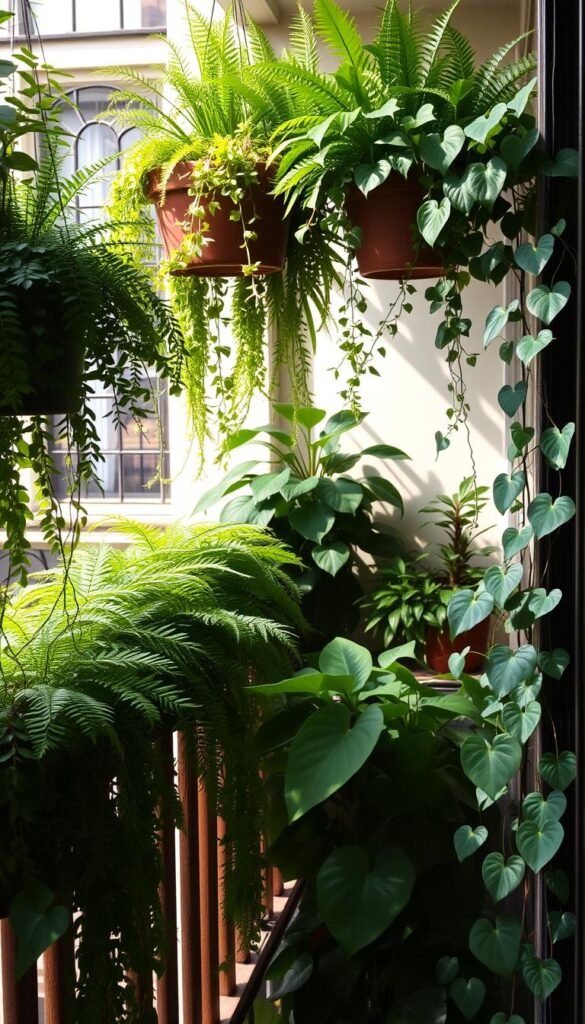Think your shaded outdoor space can’t thrive with greenery? Think again. Many urban dwellers discover their balcony’s limited light actually offers unique advantages. Reduced sunlight means less risk of leaf scorch, and container-grown varieties become easier to rearrange as seasons change.
Expert growers often recommend focusing on foliage texture rather than flower quantity. Species with thick, broad leaves tend to adapt well to filtered light conditions. These natural survivors evolved under forest canopies, making them perfect candidates for your elevated garden retreat.
This guide walks you through smart plant choices that bring life to dim corners. You’ll learn care tips for potted arrangements and discover blooming options that add splashes of color. From soil mixes to creative layout ideas, we cover practical solutions tailored for compact spaces.
Ready to reimagine your outdoor area? Let’s explore how strategic gardening techniques can turn challenging conditions into design opportunities. Your shady nook might just become your favorite spot for morning coffee or evening relaxation.
Understanding Your Shady Balcony Environment
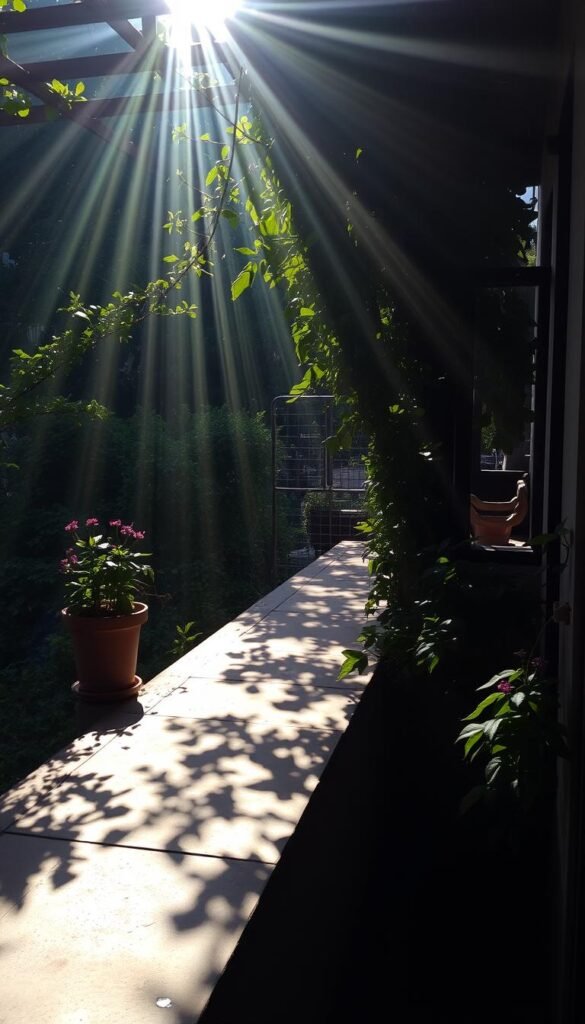
What if your balcony’s dim corners could become its greatest strength? Start by observing how sunlight interacts with your space. Track morning rays that peek through buildings or trees—even two hours of gentle sun can make a difference. Use a light meter app or simply note where shadows fall throughout the day.
Light and Space: Your Secret Weapons
Walls aren’t just structural elements—they bounce light! Measure how close containers sit to these surfaces. Reflected light from pale walls often provides enough brightness for leafy greens. Cooler temperatures in these areas help prevent soil from drying too quickly, giving plants a hydration advantage.
| Light Condition | Duration | Best For |
|---|---|---|
| Morning Sun | 1-3 hours | Variegated foliage |
| Filtered Light | 4+ hours | Ferns & mosses |
| Reflected Light | All day | Herbs & trailing vines |
Why Shade Surprises Gardeners
Limited direct sunlight means fewer scorched leaves and reduced watering stress. Slugs avoid climbing to elevated spaces, giving your container arrangements natural pest protection. These conditions favor plants that thrive in stable environments—perfect for busy urban growers.
By mapping your balcony’s unique light patterns and microclimates, you’ll unlock its hidden potential. This knowledge becomes your roadmap for selecting greenery that doesn’t just survive but actively thrives in your elevated oasis.
Top Picks: Best Low-Light Plants for Shady Balconies
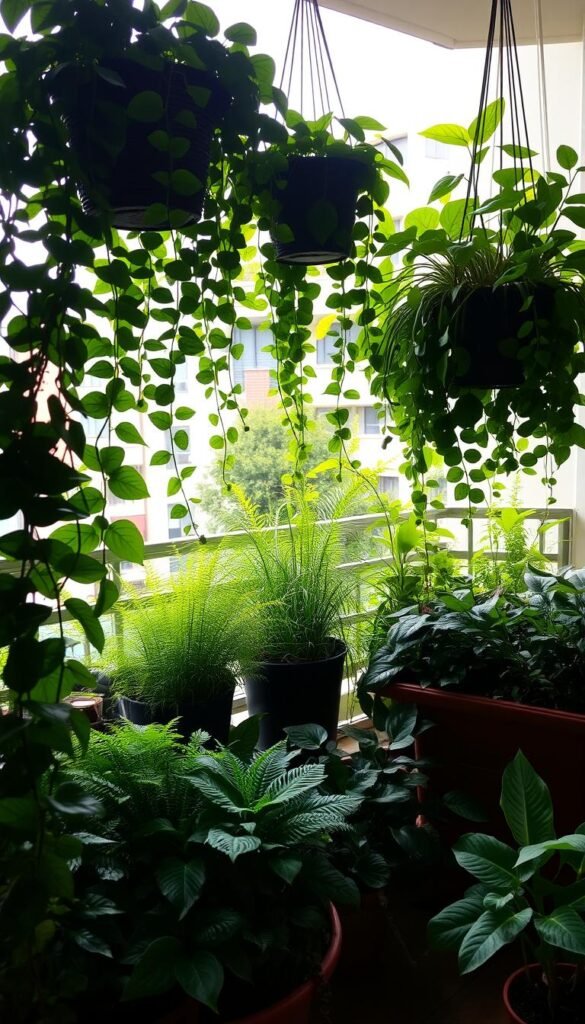
Curating the right greenery for limited-light areas starts with smart container choices. Urban gardeners often overlook how adaptable certain species become when potted. Let’s explore varieties that flourish while adding depth to your elevated retreat.
Versatile Varieties and Maintenance Essentials
| Plant | Light Needs | Care Tip |
|---|---|---|
| Snake Plant | Indirect light | Water every 3 weeks |
| ZZ Plant | Low to moderate | Use well-draining soil |
| Pothos | Filtered sun | Trim monthly |
Select containers with drainage holes to prevent root rot. Wider pots suit spreading roots of ferns, while tall planters support vining species. Lightweight resin pots make rearranging simpler as sun patterns shift.
Quality potting mix matters more in shade. Blend in perlite for air pockets. Check soil moisture before watering—poke your finger an inch deep. Overwatering causes more issues than underwatering here.
Rotate pots quarterly to ensure even growth. Pair leafy specimens with colorful container gardening accents for visual contrast. This approach keeps your garden lively despite limited direct sunlight.
Bright Blooms and Colorful Accents for Shade
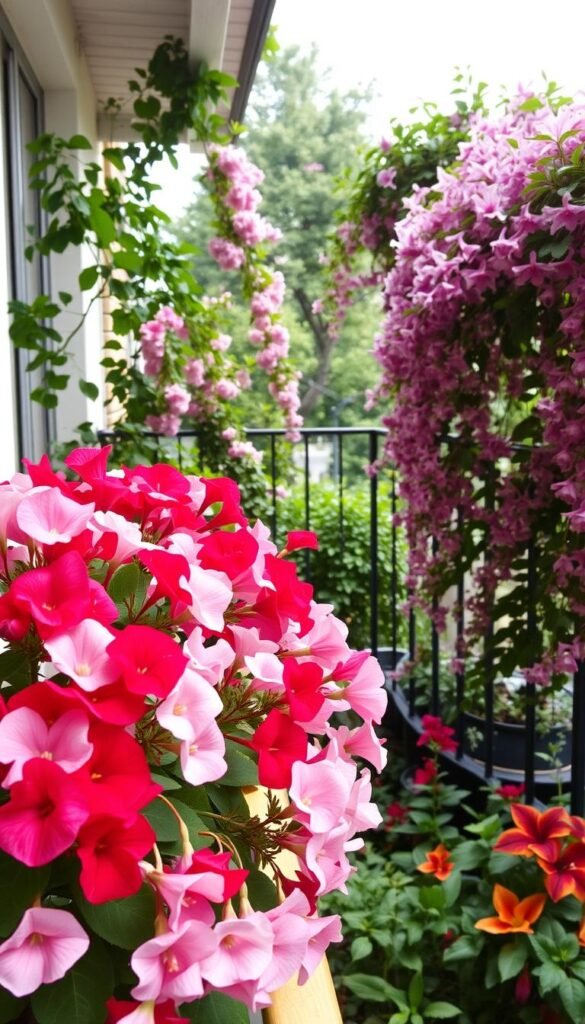
Shaded spaces become canvases for vibrant color when you choose the right blooms. Sun shade acts like a natural spotlight, making bold hues pop against muted backgrounds. Let’s explore how to turn dim corners into lively displays.
Flowering Options That Stand Out
Impatiens and fuchsia steal the show with their jewel-toned petals. These varieties thrive in filtered light, offering months of continuous color. Chocolate vine adds drama with its unique maroon blooms and sweet fragrance.
| Plant | Light Needs | Bloom Time |
|---|---|---|
| New Guinea Impatiens | Filtered sun | Spring-Fall |
| Fuchsia ‘Gartenmeister’ | Morning light | Summer |
| Chocolate Vine | Dappled shade | Late Spring |
Mixing Colors and Textures for Impact
Pair deep purples with lime-green foliage for instant contrast. Cascading lobelia in cobalt blue creates flowing accents against broad-leafed hostas. Experts suggest grouping three complementary shades in odd-numbered clusters for visual harmony.
Add depth with variegated leaves or velvety textures. A mix of upright and trailing plants gives your design vertical interest. Rotate seasonal bloomers to maintain year-round appeal without overcrowding your space.
Herbs and Edible Choices in Low-Light Conditions
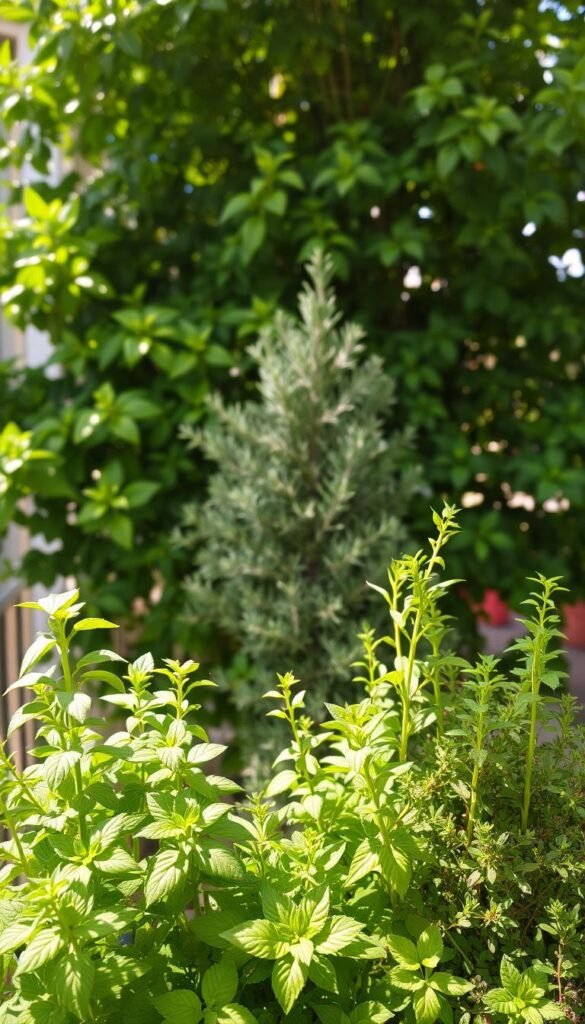
Who says shady spots can’t grow fresh flavors? Many culinary herbs actually develop richer tastes when protected from harsh afternoon rays. These adaptable plants evolved under tree canopies, making them natural fits for your elevated garden.
Nature’s Flavor Hack
Delicate leaves like mint and parsley conserve energy in filtered light, producing intense aromas without bitterness. Cooler temperatures slow growth, letting essential oils concentrate. Try Corsican mint—its tiny leaves pack a peppery punch perfect for summer drinks.
| Herb | Light Needs | Care Tip |
|---|---|---|
| Sweet Mint | 2-3 hrs indirect | Trim weekly |
| Curly Parsley | Morning sun | Feed monthly |
| Corsican Mint | Dappled shade | Mist leaves |
Smart Setup Strategies
Start with quality potting soil mixed with perlite for drainage. Shallow-rooted herbs thrive in 8-inch-deep containers. Water when the topsoil feels dry—overwatering drowns roots faster in shade.
Rotate pots every spring to balance growth. For year-round harvests, check out these top food crops that pair well with herbs. Mix textures like fuzzy sage and glossy spinach for visual interest while maximizing your edible range.
Foliage Favorites: Hostas, Ferns, and More
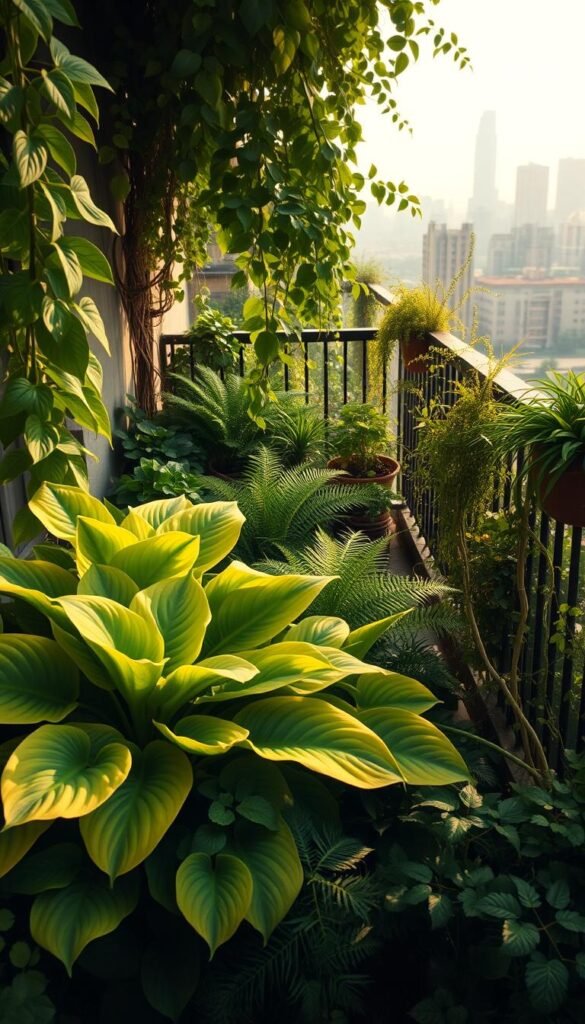
Transform your shaded balcony into a textured retreat with plants celebrated for their striking leaves. Garden designer Susan Hampton notes that ferns and hostas create living screens while adding sophisticated style. Their layered growth patterns turn bland walls into dynamic green backdrops.
Enhancing Texture with Lush Greenery
Vary your plant heights to craft depth. Tall ostrich ferns (36″ height) pair beautifully with medium-sized hostas, while trailing ivy spills over railings. Add pops of color with coleus varieties—their burgundy and lime leaves thrive in filtered light.
| Plant | Height | Texture |
|---|---|---|
| Japanese Painted Fern | 18″ | Feathery |
| Blue Hosta | 24″ | Ribbed |
| Coleus ‘Rainbow’ | 12″ | Crinkled |
Water these foliage stars when soil feels dry 1″ below surface. Morning light keeps colors vibrant without scorching leaves. Rotate pots monthly for even growth—especially important for ferns that lean toward light sources.
Mix broad hosta leaves with fine-textured maidenhair ferns for contrast. Try urban container setups using stacked planters to maximize vertical space. This approach turns limited areas into lush, layered escapes that feel larger than they are.
Integrating Large Shrubs and Vining Plants
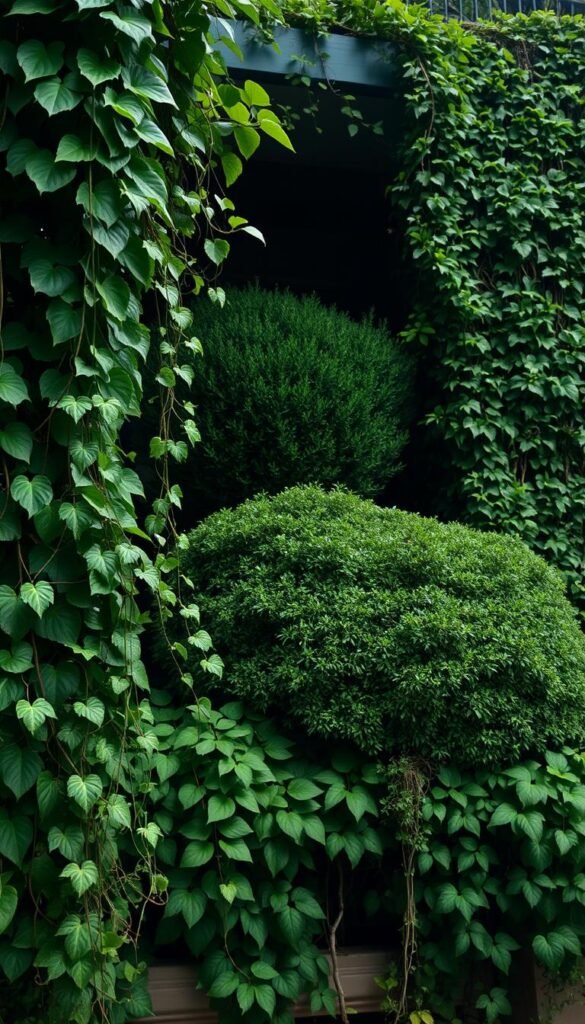
Ever considered turning your balcony’s shadows into living architecture? Strategic placement of vertical growers transforms overlooked corners into lush retreats. These natural structures filter noise while adding depth to compact spaces.
Green Curtains That Breathe
Train climbing varieties like English ivy along wire grids for instant privacy screens. Star jasmine offers fragrant blooms in partial full shade, thriving with just 2-3 hours of morning sun. Use lightweight trellises that attach to railings without drilling.
| Plant | Light Needs | Key Feature |
|---|---|---|
| Climbing Hydrangea | Full shade | Winter interest |
| Virginia Creeper | Partial shade | Fall color |
| Impatiens ‘Sunpatiens’ | Filtered light | Continuous blooms |
Shrubs That Shape Your Space
Dwarf camellias thrive in containers under full shade, their glossy leaves reflecting ambient light. Prune in early spring to control growth—this timing prevents stress during active growing seasons. Rotate pots quarterly to ensure even exposure to available light sources.
Balance is key: let shrubs receive gentle morning rays but shield them from harsh afternoon sun. Pair vining plants with broad-leafed companions like hostas for textural contrast. This layered approach maximizes visual impact while working with your balcony’s natural light patterns.
Bringing Your Shady Balcony Oasis to Life
Ready to turn your shaded balcony into a lush retreat? Start by embracing its unique light conditions—what seems limiting actually protects plants from harsh sunburn. Successful urban gardens begin with three steps: mapping sunlight patterns, choosing adaptable container plants, and layering textures for visual depth.
Balance practicality with creativity. Use pots that drain well and soil mixes rich in organic matter. Pair trailing ivy with bold coleus leaves, or mix edible herbs between flowering impatiens. Rotate arrangements seasonally—celebrate spring’s fresh growth, summer’s vibrant blooms, and autumn’s rich foliage.
Gardeners across the U.S. prove even north-facing spaces thrive with smart choices. One New Yorker transformed her fire escape using ferns and dwarf hydrangeas, while a Seattle resident created privacy screens with climbing jasmine. Your space can evolve yearly as you discover which plants flourish in your microclimate.
Remember: shade gardening rewards experimentation. Start small with two or three varieties, then expand as confidence grows. With thoughtful care and playful design, your balcony will become a living sanctuary that surprises you season after season.

